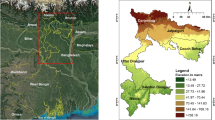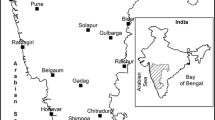Abstract
The main aim of this study was to investigate the temporal trends in maximum (T max), minimum (T min) temperature and diurnal temperature range (DTR) at annual and seasonal basis for seven sites in north-west region of India. The analysis was carried out for period of 31 years (1970–2000). The magnitude of trends and their significance were determined using Sen’s slope and Mann–Kendall methods. Additionally, persistence analysis of annual average DTR and mean temperature (T mean) has been carried out using cumulative annual mean (CAM) method. It is clear from the results that during last three decades the majority of sites showed decrease/(increases) in DTR/(T min) trends for seasonal and annual time scale. While, trends in annual and seasonal T max were observed insignificant. CAM analysis demonstrated that T mean has increased consistently since 1987–1988 onwards at majority of the sites. Further, correlation analysis revealed that rainfall along with potential evapotranspiration may be one of the important reasons for observed DTR decrease.





Similar content being viewed by others
References
Bhutiyani MR, Kale VS, Pawar NJ (2007) Long-term trends in maximum, minimum and mean annual air temperatures across the Northwestern Himalaya during the twentieth century. Clim Change 85:159–177
Braganza K, Karoly DJ, Arblaster JM (2004) Diurnal temperature range as an index of global climate change during the twentieth century. Geophys Res Lett 31(13):L13217
Chattopadhyay S, Jhajharia D, Chattopadhyay G (2011) Univariate modelling of monthly maximum temperature time series over northeast India: neural network versus Yule–Walker equation based approach. Meteor Appl 18:70–82
Clark PU, Alley RB, Pollard D (1999) Northern Hemisphere ice-sheet influences on global climate change. Science 286:1104–1111
Cure JD, Acock B (1986) Crop responses to carbon dioxide doubling: a literature survey. Agric For Meteorol 8:127–145
Dai A, Trenberth KE, Karl TR (1999) Effects of clouds, soil moisture, precipitation, and water vapor on diurnal temperature range. J Clim 12:2451–2473
De US, Dube RK, Rao GSP (2005) Extreme weather events over India in the last 100 years. J Indian Geophys Union 9(3):173–187
Dinpashoh Y, Jhajharia D, Fakheri-Fard A, Singh VP, Kahya E (2011) Trends in reference evapotranspiration over Iran. J Hydrol 399:422–433
Dinpashoh Y, Mirabbasi R, Jhajharia D, Abianeh H, Mostafaeipour A (2013) Effect of short-term and long-term persistence on identification of temporal trends. J Hydrol Eng 19:617–625
Douglass DH, Pearson BD, Singer SF, Knappenberger PC, Michaels PJ (2004) Disparity of tropospheric and surface temperature trends: new evidence. Geophys Res Lett 31:L13207
Duhan D, Pandey A, Gahalaut KPS, Pandey RP (2013) Spatial and temporal variability in maximum, minimum and mean air temperatures at Madhya Pradesh in central India. C R Geosci 345:3–21
Easterling DR, Horton B, Jones PD, Peterson TC, Karl TR, Parker DE, Salinger MJ, Razuvayev V, Plummer N, Jamason P, Folland CK (1997) Maximum and minimum temperature trends for the globe. Science 277:364–367
Easterling DR, Meehl GA, Parmesan C, Changnon SA, Karl TR, Mearns LO (2000) Climate extremes: observations, modeling, and impacts. Science 289:2068–2074
Fowler HJ, Archer DR (2005) Conflicting signals of climatic change in the Upper Indus basin. J Clim 19:4276–4293
Hansen J, Ruedy R, Sato M, Imhoff M, Lawrence W, Easterling D, Peterson T, Karl T (2001) A closer look at United States and global surface temperature change. J Geophys Res 106:23947–23963
Hasanean HM, Bssset AH (2006) Variability of summer temperature over Egypt. Int J Climatol 26:1619–1634
Huntington TG (2006) Evidence for intensification of the global water cycle: review and synthesis. J Hydrol 319:83–95
Intergovernmental Panel on Climate Change (IPCC) (2007) Climate change 2007: the scientific basis-contribution of working group I to the fourth assessment report of intergovernmental panel on climate change. Cambridge University Press, Cambridge
Jaagus J (2006) Climatic changes in Estonia during the second half of the 20th century in relationship with changes in large-scale atmospheric circulation. Theor Appl Climatol 83:77–88
Jacobs CMJ, De Bruin HAR (1992) The sensitivity of regional transpiration to land-surface characteristics: significance of feedback. J Clim 5:683–698
Jain SK, Kumar V (2012) Trend analysis of rainfall and temperature data for India. Curr Sci 102(1):37–49
Jhajharia D, Singh VP (2010) Trends in temperature, diurnal temperature range and sunshine duration in Northeast India. Int J Climatol 31:1353–1367
Jhajharia D, Shrivastava SK, Sarkar D, Sarkar S (2009) Temporal characteristics of pan evaporation trends under the humid conditions of northeast India. Agric For Meteor 149:763–770
Jhajharia D, Chattopadhyay S, Choudhary RR, Dev V, Singh VP, Lal S (2012a) Influence of climate on incidences of malaria in the Thar Desert, northwest India. Int J Climatol 33:312–325
Jhajharia D, Yadav BK, Maske S, Chattopadhyay S, Kar AK (2012b) Identification of trends in rainfall, rainy days and 24 h maximum rainfall over subtropical Assam in northeast India. C R Geosci 344:1–13
Jhajharia D, Dinpashoh Y, Kahya E, Choudhary RR, Singh VP (2013) Trends in temperature over Godavari River basin in Southern Peninsular India. Int J Climatol 34:1369–1384
Jones PD (1995) Recent variation in mean temperature and diurnal temperature range in Antarctica. Geophys Res Lett 22(11):1345–1348
Karl TR, Jones PD, Knight RW, Kukla G, Plummer N, Razuvayev V, Gallo KP, Lindseay J, Charlson RJ, Peterson TC (1993) Asymmetric trends of daily 738 maximum and minimum temperature. Bull Am Meteorol Soc 74:1007–1023
Kothawale DR, Rupa Kumar K (2005) On the recent changes in surface temperature trends over India. Geophys Res Lett 32:L18714
Kothawale DR, Krishna KK, Srinivasan G (2012) Spatial asymmetry of temperature trends over India and possible role of aerosols. Theor Appl Climatol. doi:10.1007/s00704-012-0628-8
Lauritsen RG, Rogersjeffrey C (2012) U.S. diurnal temperature range variability and regional causal mechanisms, 1901–2002. J Clim 25:7216–7231
Lozowski EP, Charlton RB, Nguyen CD, Wilson JD (1989) The use of cumulative monthly mean temperature anomalies in the analysis of local interannual climate variability. J Clim 2:1059–1068
Makowski K, Wild M, Ohmura A (2008) Diurnal temperature range over Europe between 1950 and 2005. Atmos Chem Phys 8:6483–6498
Mallik C, Lal S (2011) Changing long term trends in tropospheric temperature over two megacities in the Indo-Gangetic Plains. Curr Sci 101(5):637–644
Mitchell JR, Davis W, Senior C (1995) On surface temperature, greenhouse gases, 764 and aerosols: models and observations. J Clim 8:2364–2386
Modarres R, da Silva V (2007) Rainfall trends in arid and semi-arid regions of Iran. J Arid
Mosmann V, Castro A, Fraile R, Dessens J, Sanches JL (2004) Detection of statistically
New M, Hulme M, Jones PD (2000) Representing twentieth century space-time climate variability. Part 2: development of 1901–96 monthly grids of terrestrial surface climate. J Clim 13:2217–2238
Pal I, Al-Tabbaa A (2010) Long-term changes and variability of monthly extreme temperatures in India. Theor Appl Climatol 100:45–56
Parrya ML, Rosenzweig C, Iglesias A, Livermore M, Fischer G (2004) Effects of climate change on global food production under SRES emissions and socio-economic scenarios. Glob Environ Change 14:53–67
Partal T, Kahya E (2006) Trend analysis in Turkish precipitation data. Hydrol Process 20(9):2011–2026
Pavia EG, Graef F (2002) The recent rainfall climatology of the Mediterranean Californias. J Clim 15:2697–2701
Pingale SM, Khare D, Jat MK, Adamowski J (2013) Spatial and temporal trends of mean and extreme rainfall and temperature for the 33 urban centres of the arid and semi-arid state of Rajasthan, India. Atmos Res 138:73–90
Rai A, Joshi MK, Pandey AC (2011) Variations in diurnal temperature range over India: under global warming scenario. J Geophys Res 117:D02114
Rogers DJ, Randolph SE, Snow RW, Hay SI (2002) Satellite imagery in the study and forecast of malaria. Nature 415:710–715
Roy SS, Balling RC (2005) Analysis of trends in maximum and minimum temperature, diurnal temperature range, and cloud cover over India. Geophys Res Lett 32:L12702
Rrutsaert W, Parlange MB (1998) Hydrologic cycle explains the evaporation paradox. Nature 396:30
Ruddiman WF (2003) Orbital insolation, ice volume, and greenhouse gases. Quat Sci Rev 22:1597–1629
Rupa Kumar K, Kumar KK, Pant GB (1994) Diurnal asymmetry of surface temperature trends over India. Geophys Res Lett 21(8):677–680
Singh P, Kumar V, Thomas T, Arora M (2008) Basin-wide assessment of temperature trends in the north-west and central India. Hydrol Sci J 53:421–433
Subash N, Sikka AK, Ram Mohan HS (2010) An investigation into observational characteristics of rainfall and temperature in Central Northeast India—a historical perspective 1889–2008. Theor Appl Climatol 103:305–319
Tabari H, Hosseinzadeh TP (2011) Recent trends of mean maximum and minimum air temperatures in the western half of Iran. Meteor Atmos Phys 111:121–131
Thapliyal V, Kulshrestha SM (1991) Climate changes and trends over India. Mausam 42:333–338
Vinnikov KY, Groisman PY, Lugina KM (1990) Empirical data on contemporary global climate changes (temperature and precipitation). J Clim 3:662–677
Vose RS, Easterling DR, Gleason B (2005) Maximum and minimum temperature trends for the globe: an update through 2004. Geophys Res Lett 32:L23822
Walther GR, Post E, Convey P, Menzel A, Parmesan C, Beebee TJC, Fromentin JM, Hoegh-Guldberg O, Bairlein F (2002) Ecological responses to recent climate change. Nature 416:389–395
Wigley TML, Ammann CM, Santer BD, Raper SCB (2005) Effect of climate sensitivity on the response to volcanic forcing. J Geophys Res 110:D09107
Xia X (2013) Variability and trend of diurnal temperature range in China. Ann Geophys 31:795–804
Yadav RR, Park WK, Singh J, Dubey B (2004) Do the western Himalayas defy global warming? Geophys Res Lett 31:L17201
Zhang J, Reid JS (2010) A decadal regional and global trend analysis of the aerosol optical depth using a data assimilation grade overwater MODIS and Level 2 MISR aerosol product. Atmos Chem Phys 10:10949–10963
Zhou L, Dickinson R, Dai A, Dirmeyer P (2010) Detection and attribution of anthropogenic forcing to diurnal temperature range changes from 1950 to 1999: comparing multi-model simulations with observations. Clim Dyn 35:1289–1307
Acknowledgments
The study is supported by research grant (Senior research fellowship) from Council for Scientific and Industrial Research (CSIR), New Delhi. Authors also acknowledge to Indian Meteorological Department (IMD), India and India Water Portal Meteorological Organization.
Author information
Authors and Affiliations
Corresponding author
Rights and permissions
About this article
Cite this article
Punia, M., Nain, S., Kumar, A. et al. Analysis of temperature variability over north-west part of India for the period 1970–2000. Nat Hazards 75, 935–952 (2015). https://doi.org/10.1007/s11069-014-1352-8
Received:
Accepted:
Published:
Issue Date:
DOI: https://doi.org/10.1007/s11069-014-1352-8




